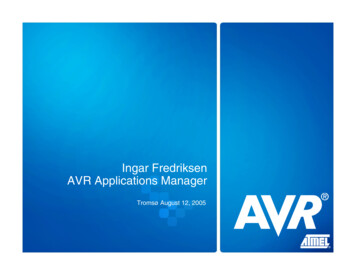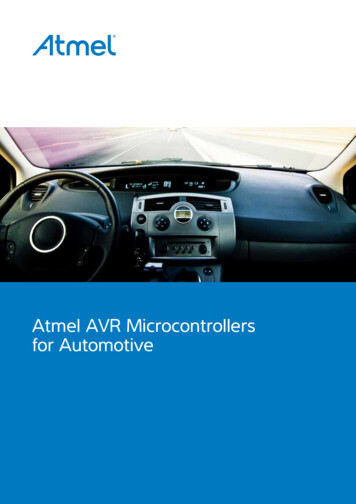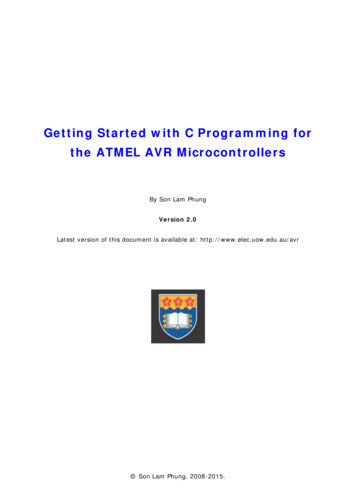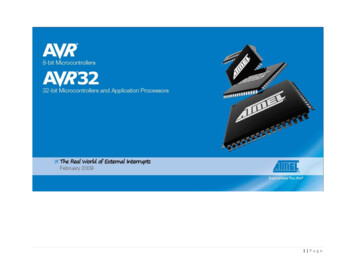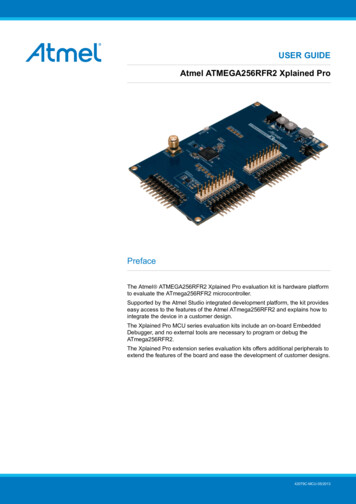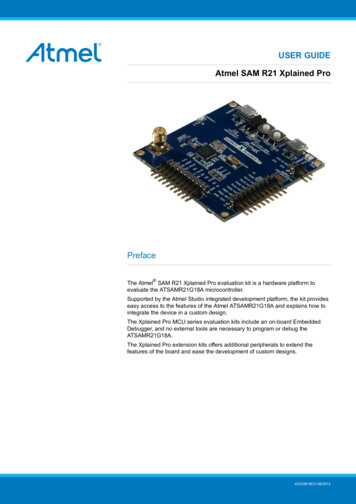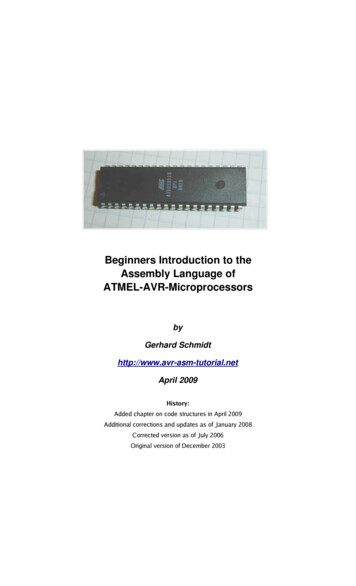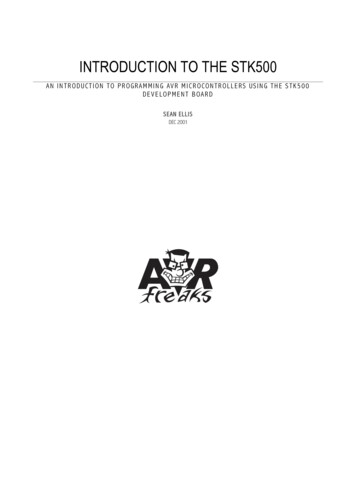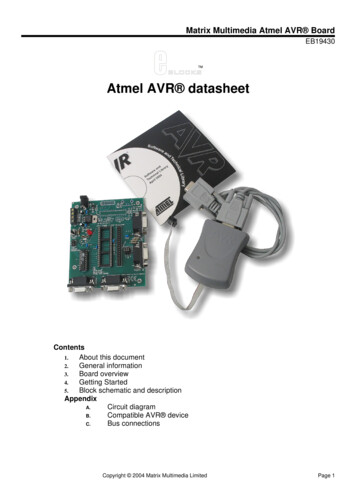
Transcription
Matrix Multimedia Atmel AVR BoardEB19430Atmel AVR datasheetContents1.About this document2.General information3.Board overview4.Getting Started5.Block schematic and descriptionAppendixA.Circuit diagramB.Compatible AVR deviceC.Bus connectionsCopyright 2004 Matrix Multimedia LimitedPage 1
Matrix Multimedia Atmel AVR BoardEB194301About this documentThis document concerns the Matrix Atmel AVR Board code EB-194-00-1.Trademarks and CopyrightPIC, PICmicro are registered trademarks of Arizona Microchip Inc.E-blocks is a trademark of Matrix Multimedia Limited.EB-194-00-1 and associates software and documentation are Copyright 2004 Matrix MultimediaLimited.Other sources of informationThere are various other documents and sources that you may find useful:Getting started with E-Blocks.pdfThis describes the E-blocks system and how it can be used to develop complete systems forlearning electronics and for PICmicro programming.DisclaimerThe information in this document is correct at the time of going to press. Matrix Multimediareserves the right to change specifications from time to time.Technical supportIf you have any problems operating this product then please refer to the troubleshooting section ofthis document first. You will find the latest software updates, FAQs and other information on ourweb site: www.matrixmultimedia.co.uk. If you still have problems please email us at:support@matrixmultimedia.co.uk. When emailing please state the operating system, the version ofPPP you are using.Copyright 2004 Matrix Multimedia LimitedPage 2
Matrix Multimedia Atmel AVR BoardEB194302General informationDescriptionThis new AVR microcontroller programmer connects to your PC via an in circuit programmer toprovide you with one of the world’s lowest cost and most flexible AVR microcontrollerprogrammers. The board is fully compatible with our entire range of E-blocks allowing theinvestigation into many interesting and exciting projects.The Atmel AVR Board allows serial programming of a large selection of 20 and 40 pin AtmelAVR devices. This board uses Atmel’s AVR studio – a free and comprehensive downloadableAVR program. The board can be programmed using Assembly and C. It provides ‘clean’ accessto all I/O lines on the relevant Atmel AVR devices.Further information on E-blocks is available in a separate document entitled Introduction to Eblocks.doc.Features E-blocks compatibleLow costUsed as a programmer and as a development boardPrograms a wide range of Atmel AVR devicesFull suite of programming softwareXtal operation and internal RC operation4 full I/O portsCopyright 2004 Matrix Multimedia LimitedPage 3
Matrix Multimedia Atmel AVR BoardEB194303Board overview1. Screw Terminals2. Power connector (positive outer – negative inner)3. Reset switch4. AVRISP programming connector5. 20-way AVR socket with AVR device6. 40-way AVR socket7. 40-way header mirroring AVR pins8. Defualt programming block9. Port A I/O10. Port B I/O11. Port C I/O12. Port D I/OCopyright 2004 Matrix Multimedia LimitedPage 4
Matrix Multimedia Atmel AVR BoardEB194304Getting Started4.1Installation instructions - SoftwareInstalling AVR Studio 4 from AVR ISP CD1.2.3.4.5.6.Insert Atmel AVR CD into CD drive.Click ‘Start’ in the pop-up screen. The AVR web page will now be running from the CD.Click ‘Software” on the left hand toolbar.Next, click “AVR Studio 4:” This will show you all the features available using the AVRStudio softwareScroll down to the CD marked “Install AVR Studio4.xx Build (Press “Open” whenprompted). By clicking on this – then pressing “Open” when prompted, will allow you toinstall the softwareFollow the on-screen instructions.For the most –up-to-date version of this software please visit the Atmel web page at:www.atmel.comInstalling AVR Studio 4 from Atmel’s Web page1.2.3.4.5.Click on the “Products” iconUsing the left hand toolbar, click on “Microcontrollers”, then “AVR 8-bit RISC”Again using the left hand toolbar click on “Tools & Software”Scroll down to the CD marked “AVR Studio4.xx Buildxx. By clicking on this – thenpressing “Open” when prompted, will allow you to install the software.Follow the on-screen instructions.For more help and guidance on installing AVR Studio visit the Atmel Website at: www.atmel.comCopyright 2004 Matrix Multimedia LimitedPage 5
Matrix Multimedia Atmel AVR BoardEB194304.3Programming the AT90S1200Testing the Atmel AVR Board – 90S1200.hexThe following instructions explain the steps to test and use your Atmel AVR Board. Theinstructions assume that AVR Studio is installed and functional. It also assumes that the testprogram 90S1200.hex has been downloaded. This test routine is a step-by-step guide to loading aprogramming into the Atmel AVR Board.Follow these instructions to test the Atmel AVR Board1)2)3)5)6)Ensure power is supplied to all the Atmel AVR Board via the power connector J4.Insert EB-004 LED board into Port B of the Atmel AVR BoardEnsure that the Almel AVR is in correct configuration for programmingJumper links for J9, J10 and J11 are in the position marked “DEFAULT”Ensure that a 11.052MHz crystal is inserted in the Atmel AVR BoardAVRISP connected to PC and J3 of AVR Board- Connect RS232 style cable (cable provided) to PC and to AVRISP box (greybox)- Connect grey header socket (6-way) to J3 of AVR BoardEnsure the cable is placed with the tab to the outside of the AVR board (thisorientation of the header is shown on the AVR Board silk screen)For details on AVRISP connector see ‘Programming – Hardware’ in chapter 5Open AVR studio SoftwareCancel the pop-up window to open any project / files7)8)9)Click on the AVR programming symbolSelect AT90S1200 device form “Device” pop-down windowSelect the “ ” button in the Flash section as shown below10)11)Navigate to the program 90S1200.hexPress the program button. This will program the AT90S1200 with the test program90S1200.hexPress the “RESET” button (PB1) on the AVR BoardCheck the illumination of all LEDs4)12)13)This should satisfy that the Atmel AVR Board is fully functional!Copyright 2004 Matrix Multimedia LimitedPage 6
Matrix Multimedia Atmel AVR BoardEB19430Ensuring correct polarity for power supplyPositive Inner/Positive Outer polarityTo set up the correct polarity the connection symbols on the jack need to match those shownbelow.Connector dimensionsThe PSU is supplied with a number of connectors.The correct connector for Matrix Multimedia productsis:Type D5.0mm external diameter2.1mm internal diameter“D” is marked on one side, down by the pins, and“5.0x2.1” is marked on the other side.EB-019-00-1 Atmel AVR (R) Board requiresPositive Outer power supplyThe two arrows – one on the connector socket and one on the connector pin, help you select thecorrect side of the power jack, and the symbol shows the correct outer connection.Copyright 2004 Matrix Multimedia LimitedPage 7
Matrix Multimedia Atmel AVR BoardEB194305Block schematic and descriptionPC6-way IDC cableAVRISPJ3Programming HeaderFor AVRISPRecommended"DEFAULT"positionClock circuitX1C5J11J10 J9C62RB7 RB6 RB5Power supplyVpp20 Pin40 PinPB1Reset0V V OUT V OUT14VPort AJ4[RB0 - RA7]AVR devices5VPort Bregulation[RB0 - RB7]14V81J2D2J1POWER INDICATORPort DPort C[RD0 - RD7][RC0 - RC7]81J138811The AVR Board solution is made up of two parts: A circuit board that allows various slave AtmelAVR devices to be programmed, and the program to be executed ‘seamlessly’, and the Windowsbased programming utility AVR Studio.Copyright 2004 Matrix Multimedia LimitedPage 8
Matrix Multimedia Atmel AVR BoardEB19430Power SupplyThe board can be powered from an unregulated 14V supply. The regulation circuitry will withstandunregulated 20V as a maximum input voltage and 7V as a minimum. If you are using a DC powersupply then you should use a 14V setting. Power can be connected using the 2.1mm power jack(positive outer), or the screw terminal connectors J1, J2. The two “ V OUT” screw terminals aresupplied for powering other E-blocks , supplying approximately 5V. The regulator will supply upto 400mA via all outputs. LED D3 will indicate that power is connected to the board and that thevoltage regulation circuitry is fully functional.Please note connector J4 is directly connected to the J1 screw terminal pin 1 labelled ‘ 14V’,therefore any voltage input to J4 will also be available direct from pin 1 of J1. This means that‘ 14V’ will not necessarily be 14VNoteRemember that other E-blocks will have to receive 5V by placing a connecting wire from the “ VOut” screw terminal of the Multiprogrammer to the “ V” screw terminal of each E-Block thatrequires a voltage.Programming - HardwareThe AVR Board connects to a personal computer via the AVRISP or compatible device. TheAVRISP requires 5V and ground connection these are all provided on the board via theprogramming header J3.The following diagram shows the pin-out of the connector J3. The pin-out is the standard pin-outas used by AVRISP.MISO12VCCSCK34MOSI/RESET56GNDFigure showing Pin-Out of ISP header J3By default the pins RB5, RB6, and RB7 are used to program the slave AVR device. These arethe pins that provide the programming functions MOSI, MISO and SCK respectively. Due to thenature of programming it is recommended that programming pins have clean signals whenprogramming, therefore there are 120-Ohm resistors between these pins and the associated PortB pins. This is achieved by placing the 3-way link block in the “DEFAULT” mode for J9, J10 andJ11. This provides the adequate protection whilst programming.If problems occur in the programming sequence we recommend completely removing the 3-wayjumper link on J9, J10 and J11. This allows MISO, MOSI and SCK to be completely clean whilstCopyright 2004 Matrix Multimedia LimitedPage 9
Matrix Multimedia Atmel AVR BoardEB19430programming. This removes the link to Port B, so pins RB5, RB6 and RB7 are only used forprogramming.It is possible to get 100% clean signals on RB5, RB6 and RB7 by placing the 3-way jumper link inthe side opposite to that labelled “default” on J9, J10 and J11. Please note that the AVR devicescan NOT be programmed when in this state – this state is only recommended if problems withattachments in Port B occur.Programming - SoftwareThe CD ROM includes a range of development tools including an Integrated DevelopmentEnvironment for code writing in assembly and debugging, a professional C compiler, and the ISPprogramming software.DIL Sockets and I / O PortsThe slave AVR DIL sockets are wired in parallel (see table of connections below) and the portsare fed out to 4 D-type sockets grouped in ports. These signals are also available on a 40-wayheader for expansion purposes. Some of the ports will be inactive. This reflects the pin outs of thevarious AVR devices themselves. For example, the AT90S1200 only has Port B and Port D,therefore Port A and Port C are inactive. Please refer to device datasheets for availability of portoutputs on each device.NOTE – Only insert ONE Atmel AVR device at a time!Reset Push ButtonPB1 provides a reset by pulling the /RESET pin low. PB1 is pulled normally high through a resistorso that the device will not be reset during normal operation. The programming software hascontrol over the reset line during programming.Frequency SelectionBy default the board is fitted with a 11.0592 MHz crystal. The crystal fits into a small socket, whichallows the crystal to be easily changed. These frequencies are chosen as they divide down byAVR pre-scalers to give suitable frequencies for clock systems and for facilitating serialcommunication using standard baud rates.USB circuitryIn the future there may be a possibility of this device being USB compatible. The PCB has beenmanufactured with the circuitry on board to enable quick development.Note this circuitry is not suppose to be populatedCopyright 2004 Matrix Multimedia LimitedPage 10
Matrix Multimedia Atmel AVR BoardEB19430Appendix A – Circuit DiagramCopyright 2004 Matrix Multimedia LimitedPage 11
Matrix Multimedia Atmel AVR BoardEB19430Appendix B – Compatible AVR devicesThis board is designed to be as versatile as possible. This means that it has been designed sothat it maximizes the amount of AVR devices that can be used with this board.The following table shows the AVR devices that are compatible with this board:20 –Pin AVR devices40 –Pin AVR ga323LMega323The items in Red are devices that are compatible but are nolonger manufactured by Atmel . These devices can be used butare not recommended.The following diagram shows the pin-out of 20 and 40 pin AVR device that are compatible withthis board.20 Pin CompatibleAVR Device Pin Out40 Pin CompatibleAVR Device Pin OutCopyright 2004 Matrix Multimedia LimitedPage 12
Matrix Multimedia Atmel AVR BoardEB19430Appendix C - Bus connectionsExpansion busThe pin connections on the expansion bus exactly mirror the pin numbering on the 40-pin DIL socket. Note that the pin numbering on the IDC socketis slightly different to that on a DIL socket which results in the seemingly odd arrangement of pins on the IDC pin chart.Pin Comparison ChartBus RB0RB1RB2RB3RB4RB5 / MOSIRB6 / MISORB7 / 7AVCCAREFCompatible AVR Pin out20 Pin40 Pin20101011 & tions on J3 – Programming headerBus NameRB5 / MOSIRB6 / MISORB7 / SCKVDDGND/RESETJ3413265Copyright 2004 Matrix Multimedia LimitedPage 13
Matrix Multimedia Atmel AVR BoardEB19430Connections on J5 – 40 Pin header connectionsBus RB0RB1RB2RB3RB4RB5 / MOSIRB6 / MISORB7 / 7AVCCAREF20 PinDevice201054112131415161718192367891140 Pindevice1011 & 51617181920213032IDCconnector1920 & 93133353739401822Copyright 2004 Matrix Multimedia LimitedPage 14
The Atmel AVR Board allows serial programming of a large selection of 20 and 40 pin Atmel AVR devices. This board uses Atmel's AVR studio - a free and comprehensive downloadable AVR program. The board can be programmed using Assembly and C. It provides 'clean' access to all I/O lines on the relevant Atmel AVR devices.

